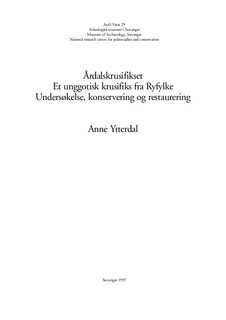| dc.contributor.author | Ytterdal, Anne | |
| dc.date.accessioned | 2012-09-29T11:03:26Z | |
| dc.date.available | 2012-09-29T11:03:26Z | |
| dc.date.issued | 1997 | |
| dc.identifier.citation | Ytterdal, Anne (1997). Årdalskrusifikset : et unggotisk krusifiks fra Ryfylke. Stavanger : Arkeologisk museum | no_NO |
| dc.identifier.isbn | 82-7760-027-5 | |
| dc.identifier.issn | 0332-6306 | |
| dc.identifier.uri | http://hdl.handle.net/11250/181458 | |
| dc.description.abstract | The crucifix from Årdal in Ryfylke is the only large medieval crucifix still in the county of Rogaland. It was presented to
Stavanger Museum in 1908 and is looked upon as the museum’s greatest treasure. Its poor state of conservation, disfiguring
overpaintings and poorly executed secondary additions resulted in it being removed from the sacred art exhibition
and put into storage. It was found to be suitable for the practical part of Anne Ytterdal’s examination in technical
conservation. The work was carried out at the Museum of Archaeology in Stavanger between January 1988 and June
1989. The crucifix underwent thorough examination using X-ray photography, computerized tomography (CT) and
ultraviolet and infrared photography. Art historians have disagreed on the exact dating of the crucifix within the 13th
century. This was clarified by the use of CT, which dated the crucifix to before 1250. The materials constituting the
crucifix and the techniques used to make it were examined and identified by ordinary binocular microscopy, wood
analysis, wet chemical analysis and analysis of cross sections in an electron microscope. The results showed that the layers
of paint and the gilding had been applied using the techniques commonly practiced in Norwegian medieval painting
whereby few pigments were mixed and used to build up simple structures on strictly limited areas. The only uncommon
usage of materials on the crucifix was the use of red lead as a pigment to imitate jewellery and the absence of underpainting
for the red lead inside the crown. The ground and paint layers on the crucifix were conserved with sturgeon glue. When
the restoration method was being decided, emphasis was placed on the prominent position which the crucifix would
occupy in the museum in the future. It was decided to remove the overpainting of the loincloth because of the poor
effect it had on the figure as a whole and the way it distorted the true experience of medieval splendour. The original
paint was intact on the face of the crucifix. The rest of the figure was treated in such a way that its surface retained the
impression of age. The damage on the figure was retouched in a manner that allowed it to remain as distinct as possible
and at the same time unobtrusive compared to the rest of the figure. The medieval colours on the crucifix were kept as
true as possible. | no_NO |
| dc.language.iso | nob | no_NO |
| dc.publisher | Arkeologisk Museum i Stavanger | no_NO |
| dc.relation.ispartofseries | AmS-Varia;29 | |
| dc.subject | arkeologi | no_NO |
| dc.subject | restaurering | |
| dc.subject | konservering | |
| dc.subject | middelalderkunst | |
| dc.subject | kirkekunst | |
| dc.title | Årdalskrusifikset : et unggotisk krusifiks fra Ryfylke : undersøkelse, konservering og restaurering | no_NO |
| dc.type | Book | no_NO |
| dc.type | Peer reviewed | |
| dc.subject.nsi | VDP::Humanities: 000::Archeology: 090::Nordic archeology: 091 | no_NO |
